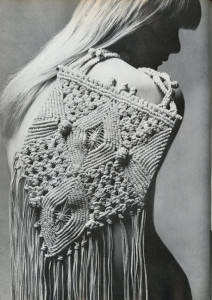Macramé is believed to have originated with 13th-century Arab weavers. These artisans knotted the excess thread and yarn along the edges of hand-loomed fabrics into decorative fringes on bath towels, shawls, and veils. The Spanish word macramé is derived from the Arabic migramah (مقرمة), believed to mean “striped towel”, “ornamental fringe” or “embroidered veil.” After the Moorish conquest, the art was taken to Spain, then to Italy, especially in the region of Liguria, and then spread through Europe. It was introduced into England at the court of Mary II in the late 17th century. Queen Mary taught the art of macramé to her ladies-in-waiting.[1]
Sailors made macramé objects in off hours while at sea, and sold or bartered them when they landed, thus spreading the art to places like China and the New World. Nineteenth-century British and American sailors made hammocks, bell fringes, and belts from macramé. They called the process “square knotting” after the knot they used most frequently. Sailors also called macramé “McNamara’s Lace”.[1]
Macramé was most popular in the Victorian era. Sylvia’s Book of Macramé Lace (1882), a favorite, showed readers how “to work rich trimmings for black and coloured costumes, both for home wear, garden parties, seaside ramblings, and balls—fairylike adornments for household and underlinens …” Most Victorian homes were adorned by this craft. Macramé was used to make household items such as tablecloths, bedspreads and curtains.[1]
Though the craze for macramé faded, it regained popularity during the 1970s as a means to make wall hangings, articles of clothing, bedspreads, small jean shorts, tablecloths, draperies, plant hangers and other furnishings. By the early 1980s macramé had again begun to fall out of fashion as a decoration trend.[2]
However macramé has become popular again. This time in the form of jewelry, such as necklaces, anklets and bracelets. Using mainly square knots this jewelry often features handmade glass beads and natural elements such as gemstones, bone or shell.
Materials used in macramé include cords made of cotton twine, linen, hemp, jute, leather or yarn. Jewelry is often made with a combination of knots and using various beads (glass, stone or wood), pendants or shells. Sometimes focal points are used for necklaces such as rings or gemstones, either wire-wrapped to allow for securing or captured in a net-like array of intertwining overhand knots.
References:
[1] Virginia Colton, ed. (1979). Complete Guide to Needlework. p. 445. ISBN 0888500858.
[2] Chace; Pennant; Warde; Wright (1981), Crafts & Hobbies, p. 28, ISBN 0-89577-063-6.
Current items available for sale can be viewed on my Etsy Page: www.etsy.com/shop/AncientEarthDesigns
